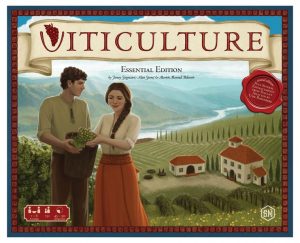Viticulture: Essential Edition Review

By MARK WILSON

Year Published: 2015
Players: 1-6
Playing Time: 45-90 Minutes
How To Play
Components
The components as a whole are lovely, and there are lots of them. Of special interest are the individually cut building pieces.
My only nitpick is that the art of the Visitors and Mama/Papa cards doesn’t match the rest of the artwork in the game, and as a result can look a little odd. It’s not bad, but neither was it a highlight for me. Others I’ve played with have commented on this as well, that they seem “off” from the art in the rest of the game.
Also, the portrait on the back of the Papa cards looks exactly like Tom Hiddleston. I point this out as an observation, not a critique. It may be a really good thing for many people.
Thematic Integration
Maybe the biggest compliment I can give this game is that it made me think about theme in a different way. Even in well-done thematic games, there are usually points where there is a gap between the theme and how your actions feel, for lack of a better descriptor.
But in Viticulture, the meeples truly feel like workers, not cubes or chits. The actions all work toward the end goal in tangible, thematic ways. I’m directing my workers to harvest grapes, make and sell wine, and usher visitors to my vineyard. It never feels like “get {x} card to do {y} action” or “acquire {x} cube/meeple/structure to accomplish {y} task.” It feels like I’m sowing fields, upgrading my facilities, and building a wine business. There’s little to no break between mechanics and theme. Even the turn order is handled thematically and strategically, with your rooster “waking you up” at a certain time, thus determining order. I feel like worker placement can lend itself to this more than many game genres, but Viticulture shines above even other entries in the genre in this respect.
So the theme is great. I like the idea of winemaking. But it’s the thematic integration with the mechanics that truly separates this as a gaming experience.
Gameplay and Balance
In previous editions, the potential imbalance of card draws was pointed out as a flaw. Apparently some tweaks have been implemented to deal with the worst of it, with a more balanced selection of visitor cards drawn from both 2nd edition and Tuscany.
That said, card draw still matters, and luck will come into play with it. In my first session, I would have won with several different visitor cards late in the game (and different wine order cards, for that matter). Alas, I got 4-5 cards that were less useful and lost by a point.
So this isn’t gone entirely. There’s plenty of strategy, but it’s not intended to be devoid of luck. I like this sort of variance, especially when it’s paired with numerous opportunities to play strategically to mitigate such swings. More strategy-minded gamers may be put off by it, though.
Otherwise, there are lots of strategic avenues to pursue, lots of interesting and nerve-wracking decision to be made, and a tangible sense of accomplishment at your efforts.
In terms of categorizing it, it’s well within the traditional worker placement genre, and if you’ve played games such as Lords of Waterdeep or Stone Age, you’ll be right at home here. As I write this, it’s listed as 2.9 weight on Board Game Geek, which feels about right compared to the 2.5 of Waterdeep and Stone Age and the 3.6 of something like Agricola.
Essential Edition Additions
The Mama and Papa cards are a simple, welcome addition. And it also gives you a “family” to own your business, if you want to take the theme deeper. Same with the field cards, which give you an additional, and often powerful, monetary option early in the game.
The rule tweaks all help to polish the game (which does sound like it was a bit rough around the edges at launch). And the new cards, as mentioned earlier, help mitigate balancing issues.
I’m not a huge solo gamer, but I was happy to give the Automa cards a try for some solo gaming. Capped at seven rounds and with one player, solo plays are a lot quicker than even 2P sessions. But in my two solo plays, both felt tense and came down to the final turn or two. I won both, but in one it came down to the final winter Automa card before my victory was assured. The difficulty can also be adjusted if you feel that the normal difficulty is too easy or hard. Personally, I feel like this is a nice way to explore the game and its strategic possibilities, but not something that’s going to match a 2-6P game in terms of excitement. But for solo gamers, this is a wonderful addition.
As a whole, what I feel the additions do is add in the best elements of Tuscany that don’t increase the complexity. If you have a dedicated gaming group, Tuscany may be the way to go. But if your cast of co-players constantly changes and rotates, as it does for me (my main group is quite large), you’re always going to be teaching the game to new players, and it’s going to be impractical to include many of the denser Tuscany modules. This is what made the EE an excellent version for me.
Length and Balance
The length can balloon considerably at higher player counts. While this isn’t necessarily a problem for a gaming crowd, this is also marketed as a couples game. If you have five of your friends over for a date night, and only 3-4 of them are gamers, I probably wouldn’t pull this, yet that seems to be what it was intended for. So I think it misses the mark for a more casual crowd with larger player counts, but can still be a satisfying 2P date night game.
Others have remarked on the balance, and I suspect there may still be scattered issues here. Getting out to an early meeple advantage isn’t always insurmountable, but sometimes feels like it (it’s possible to max out your meeples on Turn #1 with the right visitor card). “Runaway leader” is a common gaming term. Viticulture doesn’t have that, but it may sometimes have an “uncatchable” leader issue. Since the same rough point engine is being built by all players, it can be hard to close the gap that forms by midgame without a specific catch-up mechanic. While I can’t point to this as a hard rule for determining a winner, I also don’t have enough plays under my belt to offer more than anecdotal evidence. I suspect it may be an issue at times.
Alternative point options and the luck of the Visitor cards are there to mitigate this. So I’m cautiously hopeful that this concern will remain unrealized.
Losing the Theme and WP Tension
There’s a “heart” to all worker placement (WP) games, and that’s the tension of the action economy. For a WP game to truly shine, you need to feel like you always have options, but also need to feel a sense of urgency as others vie for those same options. There are WP games that lose me because they offer too much freedom, either in the form of non-overlapping strategies (i.e. “you do this, I’ll do that, and never shall we meet”) or by pushing the action to a personal player board that no one else has access to, a sort of safety net that removes the aforementioned tension.
Viticulture: EE isn’t a cutthroat game, and it does have personal player boards, but there remains enough of this tension to satiate me. Unfortunately, the next in its lineage, Tuscany: EE, I can’t say the same of. However, that’s for another review.
Additionally, a highlight of many WP games for me is how the engine you’re building feels thematic, as I outlined earlier. And again, the winemaking process feels central to the action here, and again Tuscany: EE pushes this integration away, in the form of disseminating actions further (and thus tension) and by making winemaking an afterthought. This isn’t a Tuscany: EE review, but I say that to say that I think this is the best version of the game for me. More isn’t always better, and I think it’s subtraction by addition in this case.
Conclusion
This can be a great couples’ game, works well with both newer and seasoned gamers, and has many other elements to recommend it.
I’m a fan of good worker placement games, which this certainly is, and the immersion that’s possible in the game overshadows any flaws for me.
I also think that the Essential Edition is a tangible step up for Viticulture from its 2nd Edition. I say that because, collectively, the new additions (Mamas & Papas, Field Cards, “best of” Visitor Cards, Automa, rule tweaks) definitely add some variance, depth, and heighten the theme. My estimation of the game would still be good without these elements, but wouldn’t be quite as glowing.
Tuscany: Essential Edition Expansion
There’s an additional addition for the Essential Edition (try saying that five times fast!). I did a review of it as well, which sort of doubles as a re-review of this game with the benefit of several years more of gaming. Check it out here.
…
For more content, or just to chat, find me on Twitter @BTDungeons, and if you enjoy my work, be sure to subscribe on Youtube!
Share
Recent Posts
Categories
- All (350)
- Announcements (4)
- Board Games (203)
- DMing (28)
- Game Design (16)
- Playing TTRPGs (22)
- Reviews (189)
- RPGs (142)
- Session Reports (91)
- Why Games Matter (9)